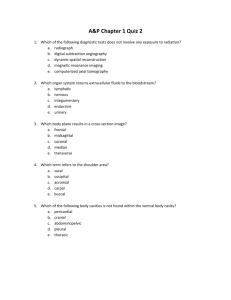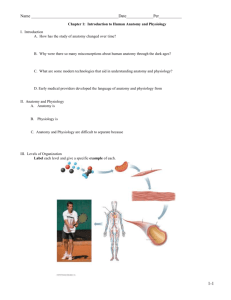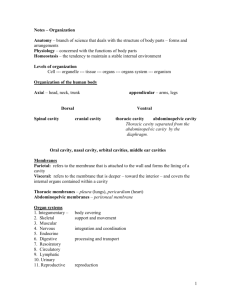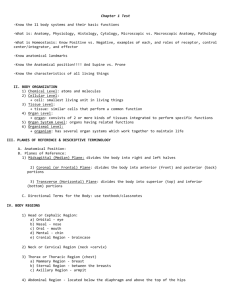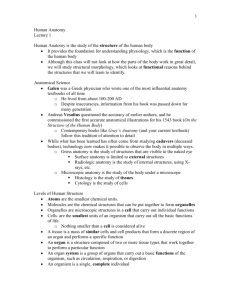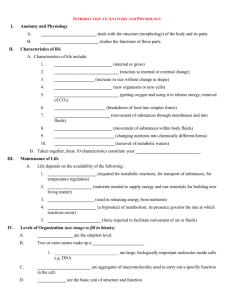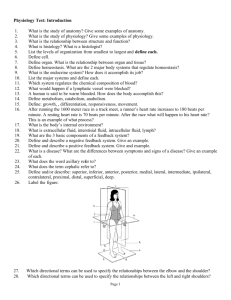HUMAN ANATOMY AND PHYSIOLOGY INTRO NOTES
advertisement
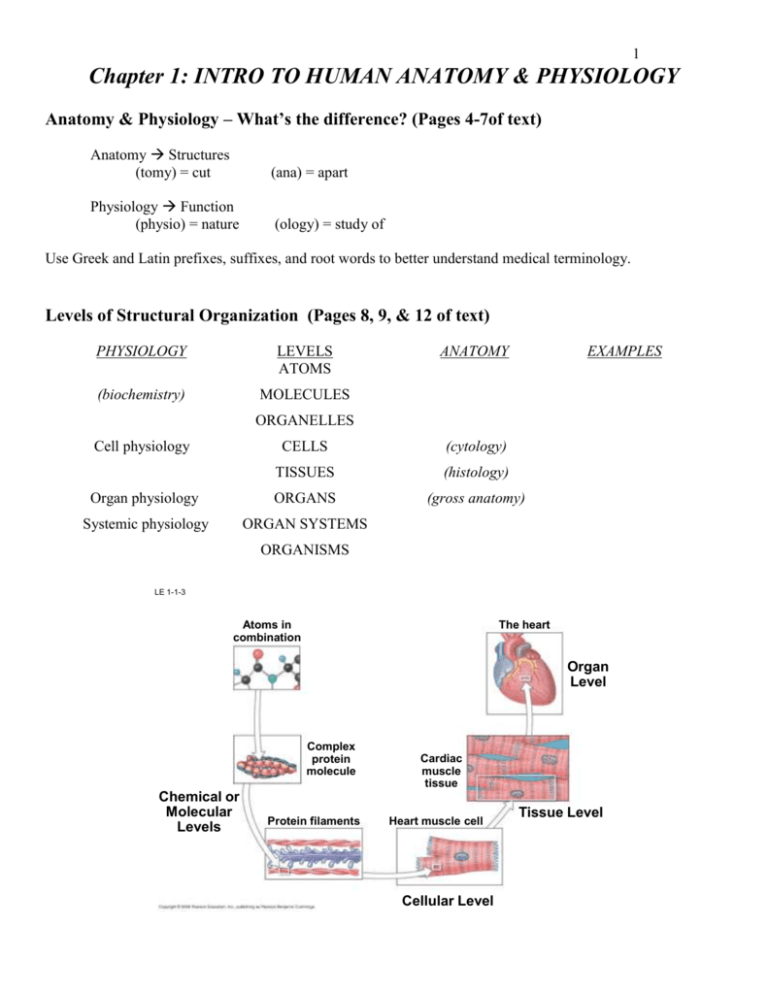
1 Chapter 1: INTRO TO HUMAN ANATOMY & PHYSIOLOGY Anatomy & Physiology – What’s the difference? (Pages 4-7of text) Anatomy Structures (tomy) = cut (ana) = apart Physiology Function (physio) = nature (ology) = study of Use Greek and Latin prefixes, suffixes, and root words to better understand medical terminology. Levels of Structural Organization (Pages 8, 9, & 12 of text) PHYSIOLOGY LEVELS ATOMS (biochemistry) MOLECULES ANATOMY EXAMPLES ORGANELLES Cell physiology CELLS (cytology) TISSUES (histology) Organ physiology ORGANS (gross anatomy) Systemic physiology ORGAN SYSTEMS ORGANISMS LE 1-1-3 Atoms in combination The heart Organ Level Complex protein molecule Chemical or Molecular Levels Protein filaments Cardiac muscle tissue Heart muscle cell Cellular Level Tissue Level 2 Human Organ Systems (Pages 10-11 of text) --note: some anatomical organs can be involved with more than one system ex. pancreas is involved with both the digestive and endocrine system A. Integumentary (skin, nails, sweat glands, hair…) protection water retention temperature regulation excretion of salts and urea Vitamin D production temp., pressure, and pain receptors of nervous system all found here B. Skeletal (bone, ligaments, and cartilage) support levers for muscles to attach protection mineral storage (calcium) blood production C. Muscular (skeletal muscles and associated tendons) movement/heat production maintaining posture facial expressions protection and support of other tissues D. Nervous (brain, spinal cord, nerves and sensory receptors) senses evaluates (makes sense of what is happening and determines what is needed) quickly activates muscles or glands E. Endocrine (hormones, pituitary, thyroid, pancreas, suprarenal, gonads, and adrenal) secrete hormones for growth, reproduction, and metabolism provides a much slower, but lasting affect within the body F. Cardiovascular (blood, vessels, and heart) sometimes called the circulatory system along with the lymphatic system. transports oxygen, carbon dioxide, nutrients, gases, wastes, hormones, and antibodies helps regulate heat, pH, and water levels helps fight disease G. Lymphatic (spleen, tonsils, thymus, lymphatic vessels and nodes) collects excess fluids from tissues and returns them to blood stream fights disease - white blood cell production H. Respiratory (lungs, bronchioles, trachea, larynx, alveoli, and nasal passage) gas exchange with blood maintains blood pH requires normal atmospheric pressure to work properly 3 I. Digestive (alimentary canal, accessory organs) food breakdown and absorption of water, ions, and macromolecules into blood elimination of indigestible substances absorption of water, vitamins and minerals, other chemicals vitamin production J. Urinary (kidneys, urinary bladder, ureter and urethra) cellular waste removal (nitrogen wastes) via the blood water, pH, and ion balance storage and removal of urine K. Reproductive Male: testes, epididymis, vas deferens, seminal vesicles, prostrate gland, penis, scrotum Female: ovaries, uterine tubes, uterus, vagina, mammary glands production of male or female sex cells (sperm/oocytes) and suspending fluids production of sex hormones supports developing embryo from conception to delivery 4 Anatomical Planes & Directions (Pages 17–21 of text) Humans have bilateral symmetry (as opposed to spherical symmetry, radial symmetry and asymmetrical body shapes). Anatomical position – standing face forward with thumbs turned and palms forward. Supine – a person lying down in anatomical position, face up Prone - a person lying down in anatomical position, face down Anatomical directions - Using 3 imaginary planes to describe where structures are in relationship to each other in the body. (3D coordinate system) 1. Using the Median or sagittal plane: Midsagittal – separated into equal right and left sides Parasagittal – not separated into equal right and left sides Medial – towards the midline Lateral – away from the midline 2. Using the Horizontal or Transverse plane (makes a cross section or axial section): Superior – above or toward the head Inferior – below or toward the feet 3. Using the Frontal or Coronal plane: Anterior – towards the front of the body Posterior – towards the back of the body Or Ventral – on the stomach side Dorsal – on the back side Or Caudal – towards the tail Cephalad – towards the head Cranial – towards the head out 5 On a human anterior and ventral mean the same thing as do posterior and dorsal. How about on a quadruped? What 2 sets of terms would mean the same thing on a dog or cat, for example? Which image shows a sagittal section of the brain? Which shows a coronal section? Which shows an axial section? Source: http://www.mrsc.ucsf.edu/~ sarang/nutmeg/help1.html July 17, 2008 4. Other anatomical directions not relating to the anatomical planes: Proximal – the part of a limb that is closer to the trunk Distal – the part of a limb that is farther away from the trunk Superficial – towards the surface Deep – more internal; away from the surface Intermediate – between 2 structures 6 7 Anatomical Regions and Cavities 1) Frontal – forehead 24) Antebrachial – forearm 2) Cranial – skull 25) Olecranon/cubital – posterior elbow 3) Facial – face 26) Antecubital – anterior surface of elbow 4) Cephalic – head 27) Carpal – wrist 5) Otic (auditory) - ear 28) Palmar – palm 6) Orbital (ocular) – eye area 29) Pollex – thumb 7) Buccal – cheek area 30) Digital – fingers, toes 8) Oral – mouth 31) Phalangeal – fingers, toes 9) Nasal – nose 32) Gluteal – buttocks 10) Mental – chin 33) Femoral – thigh 11) Cervical – neck region 34) Popliteal – posterior knee area 12) Thoracic – chest 35) Sural – (soo’ ral) – calf area 13) Mammary - breast 36) Patellar – anterior knee 14) Abdominal – lower anterior body trunk 37) Crural – lower leg (shin) 15) Umbilical – navel 38) Tarsal – ankle 16) Inguinal – where thigh meets body trunk 39) Calcaneal – heel 17) Pelvic – pelvis; above pubic 40) Plantar – sole of foot 18) Pubic – genital region 41) Pedal – foot 19) Lumbar – lower back 42) Hallux – great toe 20) Sacral – tail bone 43) Dorsal – back 21) Axillary – armpit 44) Manual – hand 22) Acromial – shoulder area 45) Vertebral - backbone 23) Brachial – upper arm 8 LE 1-6 Frons or forehead (frontal) Cephalon or head (cephalic) Cranium or skull (cranial) Facies or face (facial) Oris or mouth (oral) Mentis or chin (mental) Axilla or armpit (axillary) Brachium or arm (brachial) Antecubitis or front of elbow (antecubital) Antebrachium or forearm (antebrachial) Carpus or wrist (carpal) Nasus or nose (nasal) Oculus or eye (orbital or ocular) Auris or ear (otic) Bucca or cheek (buccal) Cervicis or neck (cervical) Thoracis or thorax, chest (thoracic) Mamma or breast (mammary) Abdomen (abdominal) Umbilicus or navel (umbilical) Crus or leg (crural) Hallux or great toe Upper limb Manus or hand (manual) Inguen or groin (inguinal) Gluteus or buttock (gluteal) Popliteus or back of knee (popliteal) Pubis (pubic) Femur or thigh (femoral) Tarsus or ankle (tarsal) Digits or phalanges or toes (digital or phalangeal) Olecranon or back Trunk of elbow (olecranal) Lumbus or loin (lumbar) Pollex or thumb Patella or kneecap (patellar) Dorsum or back (dorsal) Cervicis or neck (cervical) Pelvis (pelvic) Palma or palm (palmar) Digits or phalanges or fingers (digital or phalangeal) Acromion (acromial) Cephalon or head (cephalic) Sura or calf (sural) Calcaneus or heel of foot (calcaneal) Pes or foot (pedal) Planta or sole of foot (plantar) Lower limb 9 Body Cavities: Pages 19 & 22-24 of text Functions of Body Cavities: A. Protect internal organs by suspending and cushioning them B. Permit internal organs to increase and decrease in size without alteration of external body tissues 1) Dorsal Body Cavity (two subdivisions) a. Cranial Cavity – space inside skull b. Spinal Cavity – extends from cranial cavity to end of vertebral column 2) Ventral Body Cavity (contains visceral organs of the chest and abdomen; subdivided by diaphragm) a. Thoracic Cavity – inside rib cage; heart, lungs, etc b. Abdominopelvic Cavity – divided into abdominal cavity and pelvic cavity i. Abdominal Cavity – contains stomach, liver, intestines, etc. ii. Pelvic Cavity – contains reproductive organs, bladder, & rectum 10 4 Quadrants of abdominopelvic cavity: 1) Right upper quadrant 2) Right lower quadrant 3) Left upper quadrant 4) Left lower quadrant 11 Homeostasis (pages 12-16 of text) Many of the things that the body must do in order to survive are done subconsciously. The body’s ability to maintain an internal environment that is remarkably stable compared to the external environment is called homeostasis. Homeo = the same/unchanging Stasis = standing still Components of homeostasis: Receptor – senses a stimuli or environmental change Control center – analyzes the signals that it receives from the receptors and determines an appropriate response (brain/spinal cord) Effector – responds as directed by the control center Types of control mechanisms Negative feedback – body senses that something has changed and the control center is activated to regulate the change. This returns the body back to normal and the control center can shut off again. Negative feedback “negates” or opposes the original stimulus, minimizing change e.g. Walking outside in cold weather. Body senses drop in temperature and responds to warm the body up so that it doesn’t feel cold anymore. Once the body is warmed up, the control center turns off again. Thermoregulation, blood pressure, heart rate/pulse, etc. Positive feedback – not as common. An initial stimulus produces a response that exaggerates or enhances the change in the original conditions, rather than opposing it. The control center does not turn off but keeps the process going, strengthening the stimulus that is being sensed instead of diminishing it. e.g. Blood clotting. When you cut yourself, a blood clot begins to form. However, the blood clot that is starting to form sends out signals to further accelerate additional clotting instead of shutting down the process. Another example is the release of oxytocin to intensify the contractions that take place during childbirth. Can you think of another? 12 FigurePositive 01-05 Feedback: Blood Clotting Clotting Accelerates Positive Feedback Loop Break in blood vessels will cause bleeding Damaged cells release chemicals Clotting begins Additional chemicals released Blood clot plugs break in vessel wall; bleeding stops 13 LE 1-4 RECEPTORS Temperature sensors in skin and hypothalamus Normal temperature disturbed STIMULUS: Body temperature rises Information affects CONTROL CENTER Thermoregulatory center in brain HOMEOSTASIS Vessels dilate, sweating increases RESPONSE: Increased heat loss, body temperature drops Normal temperature restored EFFECTORS • Sweat glands in skin increase secretion • Blood vessels in skin dilate Sends commands to Body temperature (ºC) Normal body temperature 37.2 37 36.7 Vessels constrict, sweating decreases Normal range Time 14

